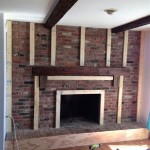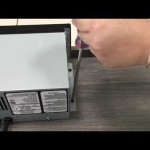Cleaning Fireplace Soot: A Comprehensive Guide
Fireplaces, while offering warmth and ambiance, inevitably produce soot as a byproduct of combustion. This dark, oily residue accumulates on fireplace walls, mantels, and surrounding surfaces, posing both aesthetic and potential health concerns. Regular and thorough cleaning is essential not only to maintain the visual appeal of the fireplace but also to ensure the safety and efficiency of its operation. This article provides a comprehensive guide to cleaning fireplace soot, covering necessary preparations, cleaning methods, and safety precautions.
Safety First: Preparation and Protection
Prior to commencing any cleaning activity involving soot, it is paramount to prioritize personal safety. Soot particles, when inhaled, can irritate the respiratory system and, over prolonged exposure, may contribute to more serious health problems. Adequate ventilation is crucial; open windows and doors to ensure a constant flow of fresh air. If natural ventilation is insufficient, consider using a fan to circulate air and direct it away from the cleaning area.
Respiratory protection is equally important. A properly fitted N95 or P100 respirator is highly recommended. These masks filter out at least 95% of airborne particles, including soot. Standard dust masks offer only limited protection and are not suitable for this task. Eye protection, in the form of safety goggles or glasses, is also necessary to prevent soot particles from entering the eyes, which can cause irritation and potential injury. Gloves, preferably disposable nitrile or rubber gloves, should be worn to protect the skin from direct contact with soot, which can be irritating and difficult to remove.
Before beginning the cleaning process, prepare the surrounding area to minimize the spread of soot. Cover furniture, carpets, and floors with drop cloths or plastic sheeting. Secure the edges of the coverings with painter's tape to prevent them from shifting during the cleaning process. Remove any decorative items from the mantel and surrounding area to further protect them from soot contamination.
Finally, ensure the fireplace is completely cold before attempting to clean it. Hot embers or surfaces can pose a significant burn hazard. Allow the fireplace to cool for at least 24 hours after the last fire, or longer if necessary, to ensure it is safe to handle.
Effective Cleaning Methods for Different Fireplace Materials
The method used to clean fireplace soot will vary depending on the material of the fireplace surround, firebox, and mantel. Different materials require different approaches to avoid damage and ensure thorough cleaning.
Brick and Stone Fireplaces: Brick and stone are porous materials, making them susceptible to soot absorption. A combination of dry and wet cleaning methods is often necessary. Begin by using a stiff-bristled brush, such as a scrub brush or wire brush (for unsealed brick or stone), to remove loose soot and debris. Work in small sections, brushing downwards to prevent the soot from spreading upwards. A vacuum cleaner with a brush attachment can also be used to remove loose soot. Be sure to use a HEPA filter to prevent soot particles from being recirculated into the air.
For more stubborn soot stains, a specialized brick or stone cleaner may be required. Follow the manufacturer's instructions carefully, testing the cleaner on an inconspicuous area first to ensure it does not damage or discolor the surface. Apply the cleaner to the affected area using a sponge or brush, allow it to dwell for the recommended time, and then scrub gently. Rinse thoroughly with clean water and allow to dry completely. In some cases, a mild solution of trisodium phosphate (TSP) and water can be used as an alternative, but exercise caution and wear appropriate protective gear, as TSP is a strong alkaline cleaner.
Painted Fireplaces: Painted surfaces require a gentler approach to avoid damaging the paint. Start by wiping down the surface with a dry microfiber cloth to remove loose soot. For more stubborn soot stains, a mild solution of dish soap and warm water can be used. Dip a soft sponge or cloth into the solution, wring out the excess water, and gently wipe the affected area. Avoid scrubbing vigorously, as this can damage the paint. Rinse the area with a clean, damp cloth to remove any soap residue and allow to dry completely.
For heavily soiled painted surfaces, a specialized soot remover designed for painted surfaces may be necessary. Always test the cleaner on an inconspicuous area first to ensure it does not damage or discolor the paint. Follow the manufacturer's instructions carefully when applying the cleaner.
Metal Fireplaces and Fireplace Doors: Metal surfaces, such as fireplace doors and metal surrounds, can be cleaned with a combination of dry and wet methods. Start by wiping down the surface with a dry microfiber cloth to remove loose soot. For more stubborn soot stains, a specialized metal cleaner or polish can be used. Apply the cleaner to a soft cloth and rub it onto the affected area in a circular motion. Buff the surface with a clean cloth to remove any residue and restore the shine. For fireplace doors with glass panels, use a specialized glass cleaner or a mixture of equal parts white vinegar and water to remove soot and grime. Spray the cleaner onto the glass and wipe it clean with a paper towel or microfiber cloth.
Mantels Made of Wood: Wood mantels require special care, as they can be easily damaged by harsh cleaners. Start by wiping down the mantel with a dry microfiber cloth to remove loose soot. For more stubborn soot stains, a mild solution of dish soap and warm water can be used. Dip a soft sponge or cloth into the solution, wring out the excess water, and gently wipe the affected area. Avoid scrubbing vigorously, as this can damage the finish. Rinse the area with a clean, damp cloth to remove any soap residue and allow to dry completely. For wood mantels with a protective finish, such as varnish or polyurethane, a furniture polish can be used to restore the shine and protect the surface.
Addressing Stubborn Soot Stains and Odors
Despite employing various cleaning methods, some soot stains may prove particularly challenging to remove. Similarly, lingering soot odors can be persistent and unpleasant. Addressing these issues requires a targeted approach.
Stubborn Soot Stains: For persistent soot stains on brick or stone, consider using a poultice. A poultice is a paste-like mixture that is applied to the stain and allowed to dry, drawing out the stain as it dries. A common poultice recipe involves mixing baking soda with water or hydrogen peroxide to form a thick paste. Apply the paste to the affected area, cover it with plastic wrap, and let it sit for several hours or overnight. Remove the plastic wrap and allow the paste to dry completely. Once dry, scrape off the paste and rinse the area with clean water. Repeat the process if necessary.
Another effective method for removing stubborn soot stains is to use a steam cleaner. The high-pressure steam can penetrate the porous surface of brick and stone, loosening the soot particles and allowing them to be easily wiped away. Use a steam cleaner with a brush attachment and work in small sections, moving the nozzle slowly and steadily over the affected area. Wipe away the loosened soot with a clean cloth.
Soot Odors: Lingering soot odors can be neutralized with various methods. One simple and effective approach is to place bowls of baking soda or activated charcoal around the room. Baking soda and activated charcoal are both excellent odor absorbers and can help to eliminate the soot smell over time. Replace the baking soda or activated charcoal every few days as needed.
Another option is to use an air purifier with a HEPA filter and activated carbon filter. The HEPA filter will remove soot particles from the air, while the activated carbon filter will absorb odors. Run the air purifier continuously for several days to help eliminate the soot smell. For more severe odors, consider using an ozone generator. Ozone generators produce ozone, a powerful oxidizing agent that can neutralize odors. However, ozone can be harmful to humans and pets, so it is important to use an ozone generator only in unoccupied spaces and follow the manufacturer's instructions carefully. Ventilate the area thoroughly after using an ozone generator.
Finally, cleaning the fireplace flue and chimney can also help to eliminate soot odors. A buildup of soot and creosote in the flue and chimney can contribute to lingering odors. Hire a professional chimney sweep to clean the flue and chimney at least once a year to prevent the buildup of soot and creosote.
Regular fireplace maintenance, including proper burning techniques (using seasoned wood, ensuring adequate airflow), and regular cleaning, will minimize soot buildup and associated issues. Prevention remains the best strategy for managing soot and maintaining a clean, safe, and enjoyable fireplace.

How To Clean Soot From A Fireplace In Hassle Free Steps Lovetoknow

Clean Soot Fireplace From Stone Furnace Oil Leaks Diesel Spills Gas Remediation

Remove Soot From Fireplace Tips For Cleaning Chimney

How Fo I Remove Fireplace Soot Smoke Hometalk

Clean And Inspect Your Chimney To Remove Sooty Deposits

Removing Soot Stains From Bricks And Stone Chimneys Com

How To Clean Soot Off Brick Fireplaces Anew

How To Clean A Fireplace Homeright

Chimney Soot And Creosote Dangers Full Service

How To Clean A Stove Cleaning Fireplaces And Fireplace Glass Fuze
Related Posts








